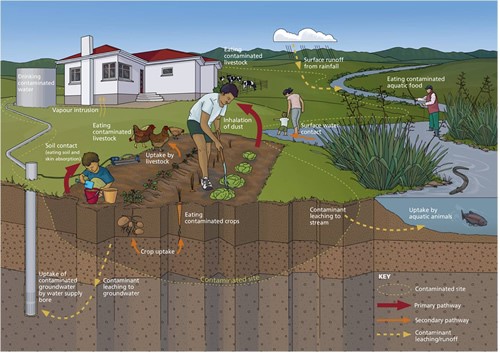What is a contaminated site?
- Land is contaminated when hazardous substances such as heavy metals and pesticides (including DDT, dieldrin, lead and arsenic) are found in the soil in concentrations above naturally occurring soil levels. You can find a detailed list of hazardous substances listed on the Ministry for the Environment’s Hazardous Activities and Industries List (HAIL) website here.
How does land become contaminated?
- Land can become contaminated from hazardous substances being used or dumped on the site, often during horticultural, agricultural or industrial activities. During the 1940s-1960s in West Auckland, there was a large number of vineyards and orchards where various sprays including pesticides containing DDT and lead arsenate were commonly used. There can also be lead-based paint associated with older homes (pre-1980s) and organochlorine pesticides from former market gardens. Other common examples of contaminated sites within the Auckland region include timber treatment sites, sheep dips, scrap yards and sites where contaminated fill was imported and used.
Why is it important I know if my site is contaminated?
- It is important to know if your site is contaminated for your health, your family’s health, as well as the health and wellbeing of your surrounding neighbours. If the site has contaminants, these can leach into streams and damage native plants, birds, fish and animals. Planning to establish a vegetable garden or to keep chickens? You could be inadvertently introducing poisons into your food sources.
- The diagram below shows the continuing flow-on effect of contamination that remains until remediation actions are taken.
 Image source: Ministry For The Environment
Image source: Ministry For The Environment
Purchasing a property to subdivide?
- It’s important to think about soil contamination and water contamination. If your LIM (Land Information Memorandum) report is tagged with site contamination, then Council may require additional testing and reports during the land subdivision process. This may add on costs to your project.
- The LIM report is a very useful tool when purchasing property. It has many valuable pieces of information about the property, including information about known or potential soil contamination.
- It is important for you and your family’s health and wellbeing to investigate the potential for soil contamination to exist at the property prior to purchasing the property or commencing any works.
- Do you have plans to subdivide or shift the soil on the property? You may face additional costs to remediate any contamination that is present in the soil.
How can I find out if the site is contaminated?
- One way is to order a LIM report which contains a summary of information that council holds for the property, including the presence (known or potential) of hazardous substances and contamination. It may contain a clause with text similar to the following:
“Council’s regulatory records indicate that there could be historic, and/or current, land use activities on, within or adjacent to this site that fall within the Hazardous Activities and Industries List (HAIL) published by the Ministry for the Environment. This list comprises activities and industries that are considered likely to cause land contamination as a result of hazardous substance use, storage, and disposal. A site contamination assessment (undertaken by a suitably qualified and experienced practitioner) and resource consent from Auckland Council may be required prior to any soil disturbance (including sampling soil), redevelopment, subdivision or change of use of the site.”
- You can also purchase a site contamination enquiry report from the local council. This is a desktop report that will list all hazardous activities registered at the site. However, it isn’t a legal requirement for council to hold a record of all activities so you might not get a complete picture of the contamination from this report.
- Ultimately, the recommended way to check for land contamination is to have soil samples taken at the site and sent to a laboratory for testing where they will be analysed for hazardous substances.
What should I do if the site I want to purchase has potential contamination? Talk to us!
- The recommended practice is to have soil samples taken at the site and tested for contamination.
- At Thomas Consultants, we offer an instant soil testing service using our unique technology offering an instant comprehensive report. Our practitioners can also give you an estimate of what the costs might be if further investigation is needed such as Preliminary Site Investigations and Detailed Site Investigations.
To find out more about Preliminary Site Investigations and Detailed Site Investigations click here.
Need more help?
We have a team of practitioners who are highly experienced in soil contamination. For any questions on land contamination or site assessments please contact us today.







